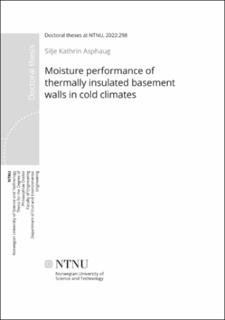| dc.contributor.advisor | Kvande, Tore | |
| dc.contributor.advisor | Time, Berit | |
| dc.contributor.advisor | Geving, Stig | |
| dc.contributor.author | Asphaug, Silje Kathrin | |
| dc.date.accessioned | 2022-09-27T13:34:49Z | |
| dc.date.available | 2022-09-27T13:34:49Z | |
| dc.date.issued | 2022 | |
| dc.identifier.isbn | 978-82-326-6744-4 | |
| dc.identifier.issn | 2703-8084 | |
| dc.identifier.uri | https://hdl.handle.net/11250/3021834 | |
| dc.description.abstract | Climate change entails frequent and intense events of heavy rainfall and rain-induced floods in many regions with cold climates. In addition, present solutions for stormwater management involve the infiltration of surface runoff into the ground surrounding the buildings. Although sufficient drainage normally prevents water pressure on the basement envelopes in new buildings, the basement envelope is still prone to high moisture strain in the form of high relative humidity (RH) in soil/backfill, precipitation/stormwater, and water from snowmelt.
The primary objective of this thesis has been to make novel contributions to the scientific knowledge regarding the effect of outward drying of thermally insulated concrete basement walls. Several scoping and desktop studies were conducted to map the extent of scientific research available. Furthermore, a novel experimental method that involved applying load cells to monitor the outward drying and precipitated condensation of concrete wall segments insulated with different configurations of thermal insulation and dimpled membranes was developed. In the experiment, the wall segments were exposed to warm interior and cold and humid exterior conditions in a climate simulator. Subsequently, numerical simulations were conducted using COMSOL Multiphysics®. The simulations were performed to investigate the concrete wall segments from the laboratory experiment and the long-term moisture performance of thermally insulated basement walls. The vapour permeability of the exterior thermal insulation, moisture performance of three types of concrete, effect of two dimpled membrane positions, and effect of interior vapour barriers were investigated.
The literature reviews and desktop studies provided an overview of the international recommendations for thermally insulated basements in cold-climate countries and studies focusing on the hygrothermal simulations of basement envelopes. Differences between the recommendations primarily pertained to the exterior damp proofing of the walls, use and position of dimpled membranes and vapour barriers, and use of vapour-permeable thermal insulation. Note that a method for the validation of the hygrothermal simulations of basements using full-scale physical measurements was not found in the literature. Therefore, it was concluded that a recognised method/procedure to determine the below-grade exterior boundary conditions is required. In the experimental study, the three basement wall segments exhibited similar drying rates. Thus, it was concluded that the outward drying was primarily limited by the concrete type and not the exterior thermal insulation or position of the dimpled membrane. This inference was validated by numerical simulations.
Using vapour-permeable thermal insulation on the exterior side of basement walls in dwellings might improve the moisture performance of the interior wall components; however, the effect of the insulation will primarily depend on the capillary moisture transfer of the concrete and the thickness and permeability of the exterior and interior insulation. If the concrete dries slowly, a dimpled membrane positioned between the concrete and exterior insulation might provide sufficient drying, assuming that the air gap behind the membrane is slightly ventilated. Therefore, the span of the moisture properties of concrete used in basements requires a thorough investigation. | en_US |
| dc.language.iso | eng | en_US |
| dc.publisher | NTNU | en_US |
| dc.relation.ispartofseries | Doctoral theses at NTNU;2022:298 | |
| dc.relation.haspart | Paper 1: Asphaug, Silje Kathrin; Kvande, Tore; Time, Berit; Peuhkuri, Ruut; Kalamees, Targo; Johansson, Pär; Berardi, Umberto; Lohne, Jardar. Moisture control strategies of habitable basements in cold climates. Building and Environment 2019 ;Volum 169. | en_US |
| dc.relation.haspart | Paper 2: Asphaug, Silje Kathrin; Time, Berit; Kvande, Tore. Hygrothermal simulations of thermally insulated basement envelopes - Importance of boundary conditions below grade. Building and Environment 2021 ;Volum 199. s. - | en_US |
| dc.relation.haspart | Paper 3: Asphaug, Silje Kathrin; Hjermann, Ingrid; Time, Berit; Kvande, Tore. Monitoring outward drying of externally insulated basement walls: A laboratory experiment. Building and Environment 2022 ;Volum 217. s. - | en_US |
| dc.relation.haspart | Paper 4: Asphaug, Silje Kathrin; Andenæs, Erlend; Time, Berit; Geving, Stig; Kvande, Tore. Moisture-resilient performance of concrete basement walls – Numerical simulations of the effect of outward drying. Building and Environment 2022 ;Volum 222. s. - | en_US |
| dc.title | Moisture performance of thermally insulated basement walls in cold climates | en_US |
| dc.type | Doctoral thesis | en_US |
| dc.subject.nsi | VDP::Teknologi: 500::Bygningsfag: 530 | en_US |
